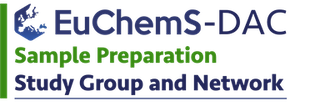TF1. Objectives
Green metrics provide data on the environmental impact of analytical procedures and help claiming the greenness of a method. They are an essential tool that also allows comparing the greenness performances between methods as well as finding the strong/weak points or aspects to be improved within an analytical procedure. Although essential, green metrics were rarely used until recently. It is often under-appreciated that in order for a method to be claimed green, an assessment of greenness is necessary and should be provided. Whether optimizing or applying an analytical procedure, the use of green metrics is critical and should precede any analytical practice including that of sample preparation.
TF1 will support our network members by answering questions on e.g., the criteria used for assessing analytical methods, the use of the corresponding open-source software, the quantification of specific criteria etc. Questions can be emailed to sampleprep<at>tuc.gr (title of email: TF1 Green Metrics) and one of the task force leaders will shortly reply. TF1 will initially focus on AGREEprep (a green metric for sample preparation methods) and will expand soon to other metric tools.
Links to metric tools:
- AGREEprep - Analytical greenness metric for sample preparation, TrAC Trends Anal. Chem. 149 (2022) 116553. https://doi.org/10.1016/j.trac.2022.116553
- A Tutorial on AGREEprep an Analytical Greenness Metric for Sample Preparation, Advances in Sample Preparation, 3 (2022) 100025. Open Access. https://doi.org/10.1016/j.sampre.2022.100025 and the corrigendum
- AGREE - Analytical GREEnness Metric Approach and Software, Anal. Chem. 92 (2020) 10076–10082. https://doi.org/10.1021/acs.analchem.0c01887
- A new tool for the evaluation of the analytical procedure: Green Analytical Procedure Index, Talanta. 181 (2018) 204–209. https://doi.org/10.1016/j.talanta.2018.01.013
-Complementary green analytical procedure index (ComplexGAPI) and software, Green Chem. 23 (2021) 8657-8665. Open Access. https://doi.org/10.1029/d1gc02318g
Links to concepts related to green sample preparation and green analytical chemistry:
- The ten principles of green sample preparation, TrAC Trends Anal. Chem. 148 (2022) 116530. Open Access. https://doi.org/10.1016/j.trac.2022.116530
- The 12 principles of green analytical chemistry and the SIGNIFICANCE mnemonic of green analytical practices, TrAC - Trends Anal. Chem. 50 (2013) 78–84. https://doi.org/10.1016/j.trac.2013.04.010
- Green Analytical Chemistry, TrAC - Trends Anal. Chem. 27 (2008) 497–511. https://doi.org/10.1016/j.trac.2008.05.003
- Green Chemistry: Theory and Practice, in: Oxford University Press, New York, 1998.
TF1. Leaders

Francisco Pena-Pereira received his PhD (2009) in Chemistry from the University of Vigo (Spain) and the Habilitation (2018) in Chemistry from the Gdańsk University of Technology (Poland). At present, he focuses on the implementation of nanomaterials in miniaturized systems for analyte sensing at the University of Vigo (Spain) as distinguished researcher. He has published 61 scientific papers, 8 book chapters and 2 books (as Editor).

Beate Gruber, received her PhD from the University of Rostock (Germany) in 2016. She then worked as a postdoctoral researcher at Organic & Biological Analytical Chemistry (ULiège), and at the Department of Biochemistry and Molecular Biology (PSU), followed by a position as a research scientist at the RIC in Belgium. Since 2019, she is a GC laboratory manager in Analytical and Material Science at BASF SE (Germany). Her expertise includes capillary gas chromatography coupled to various detection technologies, multidimensional gas chromatography and miniaturized sample preparation.

Mehmet Gumustas is an Associate Professor at the Ankara University Institute of Forensic Sciences Department of Forensic Toxicology, Ankara, Turkey. He received his PhD from Ankara University Health Science institute Department of Analytical Chemistry in 2016. He is a member of EuChemS-DAC Bioanalytics study group. His research activities focused on the development of analytical methodologies (chromatography, capillary electrophoresis, etc.) for the determination of chiral and achiral compounds, impurities as well as metabolites from different matrices.

Natalia Manousi, is a Post-Doctoral researcher in Pharmaceutical Analysis in the Department of Pharmacy of the Aristotle University of Thessaloniki, Greece. She received her PhD in Chemistry from the Laboratory of Analytical Chemistry of the Department of Chemistry of Aristotle University of Thessaloniki in 2022. Currently, her research interests focus on the development of microextraction methodologies combined with chromatographic and spectrometric techniques. Up to now, she has published more than 70 research articles and book chapters.






